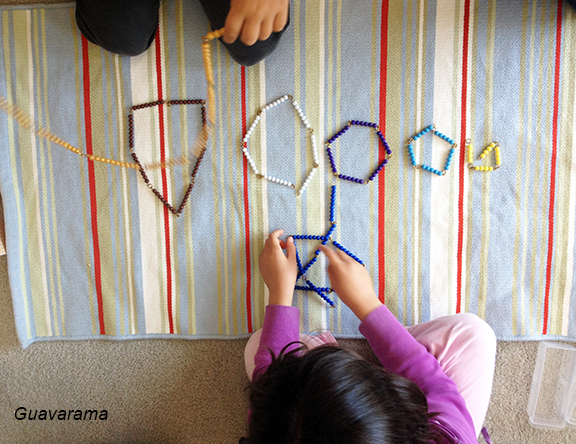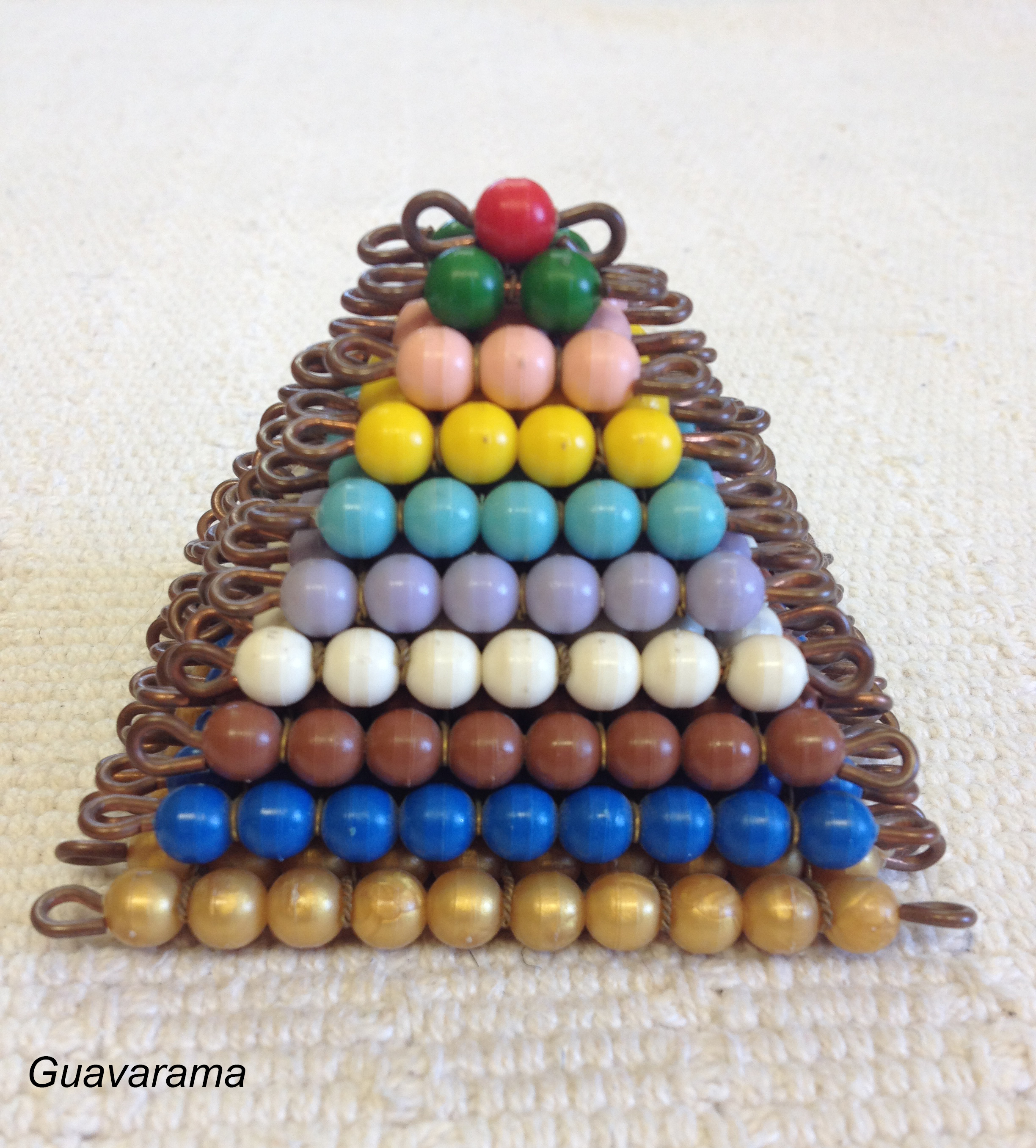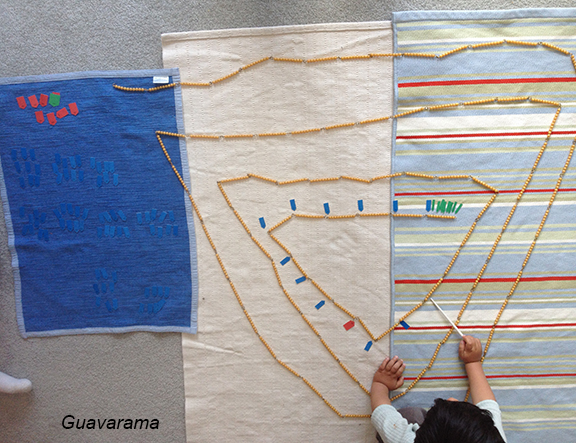Age: 4.5 and 7.5
Presentations: Making Geometric Shapes, Association of squaring chains with bead stairs (primary), Concept and notation of squares, Notation of squares layout, Finding the totals of squares, Power scales, Chain of 1000 (just work)
Because I’m in the squaring and cubing section part of the album right now in class, I’ve been giving the kids some presentations in this area recently. Last week, I presented the introduction section of squaring and cubing, which are extensions of the short chain work: Making Geometric Shapes. This is where we bring out the short bead chains, fold them into different polygons, and introduce the nomenclature.
 You can see typical Thumper reaction here at the face of new materials; she wants to play with it and make a star with the 9 chain instead of a nonagon.
You can see typical Thumper reaction here at the face of new materials; she wants to play with it and make a star with the 9 chain instead of a nonagon.  The other thing we did that day was Circumscribing One Figure Around Another. For this presentation, you show them how to circumscribe one shape inside another and introduce those two vocabularies (circumscribed and inscribed). Astroboy worked on this again today (Thursday).
The other thing we did that day was Circumscribing One Figure Around Another. For this presentation, you show them how to circumscribe one shape inside another and introduce those two vocabularies (circumscribed and inscribed). Astroboy worked on this again today (Thursday).  Because he did this after my attempt at giving him the Bead Cabinet presentations that were at the end of my primary album (whereas this activity is in my ELE album), he put all those bead bars around the circumscribed shapes. And of course he was no where super interested in my presentation. Though he was game and allowed me to finish my presentation and even helped me count. (He does love anything that has to do with pretending to be a train and lining things up.) My sister asked me what the point of this work is, circumscribing figures. I think it’s just a sensorial activity. Letting kids play with their geometric shapes. The kids also figured out by playing with it that as the shapes got larger by one unit on each side, the difference in area between shapes got larger.
Because he did this after my attempt at giving him the Bead Cabinet presentations that were at the end of my primary album (whereas this activity is in my ELE album), he put all those bead bars around the circumscribed shapes. And of course he was no where super interested in my presentation. Though he was game and allowed me to finish my presentation and even helped me count. (He does love anything that has to do with pretending to be a train and lining things up.) My sister asked me what the point of this work is, circumscribing figures. I think it’s just a sensorial activity. Letting kids play with their geometric shapes. The kids also figured out by playing with it that as the shapes got larger by one unit on each side, the difference in area between shapes got larger.

Presentation #2 in this section is introducing the concept of squares and cubes, and their notation. So we did The Concept and Notation of Squares and Notation of Squares Layout. Basically you’re just folding a long bead chain of 4 (4 4-bars) and showing it’s the same as a square, then showing the notation (4×4=4 squared = 16). She seemingly got the concept because she got bored easily. So we jumped to the next presentation of games with squares and stacked all of the squares together and I asked her how many beads she thinks are there total. This is the Finding the Totals of Squares and Cubes presentation. Oh before we go on, there is a real emphasis in Montessori math of the correlation between multiplication and geometry (but many indirect!). This will all come handy later when the kids work on geometry.

I’m again reminded the point of these presentations, which is to arouse interest and let the kids learn by doing it themselves. Because once she had to find the total by using the info I just showed her on what is a square and what the value of each square is, she could not do it. I walked her through it. On a side note, I wouldn’t let her count (I know I know, not very good teacher here) and that made her cry. Because we wrote the calculation on a whiteboard, (1 square, 2 squared, 3 squared, etc) I ended up also showing her the Power Scales presentation. In this presentation, you take the difference of each square, then take that difference, and you arrive at 2, always. For example:
- 1 squared = 1
- 2 squared = 4
- 3 squared = 9
- 4 squared = 16
But 4-1=3, 9-4=5, 16-9=7. And 5-3=2, but also 7-5=2. it’s strange and hypnotic for a person like me who likes looking at numbers. Of course, this is not what Thumper got out of it. Once she saw the pattern, she didn’t even bother doing the subtraction and just went with it to fill out the board. What she was obsessed with is how everything subtracts down to 0, again and again. She made that chart a second time so that she could see how everything subtracts down to just one zero. I’m pretty sure that was not the intent of power scale. And yet, you can’t say she’s wrong. I told her she’d have to find the magic number for cubed number but she wasn’t interested yet. On writing this I’m thinking it’s because she’s not too comfortable with her multiplication table yet. I didn’t mean to do that many presentations all at once. It just kind of happened because of the kids interest. Thumper said she liked the squares after the Notations presentation, which totally jives with what my teacher said about the squares and cubes in the classroom because children find it interesting. But then she didn’t really want to do the work on it. I think she really wanted to just explore it and play with it. Hopefully we get a chance to do that next week.

We were indeed swimming in beads this week, as Astroboy also chose to count to 1000 again. Made me all happy because the last time we did it was in January. And you never force a child to work on something in primary level. Despite me knowing that he needs the practice. It’s really strange, when he lays it out, he has no problem reading numbers or knowing what comes next. But without the notation and just counting in his head, he likes to skip. He likes to count: “….110, 111, 112, 113,….119, 200!” What’s got me so happy for Astroboy isn’t that he’s doing these things. But that he knows to get the rug out when the material sits on the carpet. He gets all offended and insists on getting more. To me this attention and being a stickler for details is a great soft skill to have. I really need to get more white rugs but I can’t justify the expense of these beautiful Asoka rugs, even though they really are the best for classwork. In terms of Montessori curriculum, you introduce squares pretty early on. First grade. I put off presenting cubes because my teacher says that often once you do the cubes, the children don’t want to go back to the squares. But I can also see from my presentations that I may need to wait a bit until I go into the harder sections of the manual. It’s the thing I’m realizing about the albums. It’s really hard to see that if you don’t work in a classroom and you’re just buying an album. You’re apt to say, “What’s the sequence and what do I do?” But if you have a good idea of all the presentations because you’ve presented them once, then from the child’s reaction you typically have an idea of when to keep going and when to wait till later. And once you know they’re at then it’s much easier to pick from anywhere in the album to present, as long as its appropriate developmentally.
